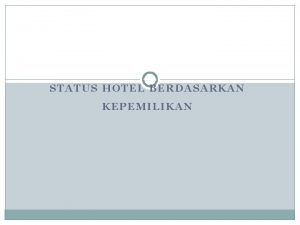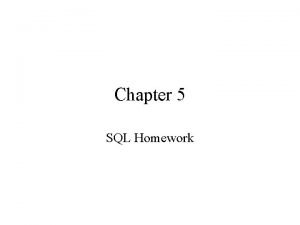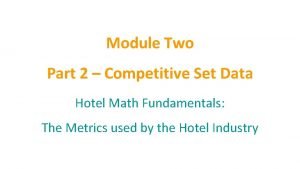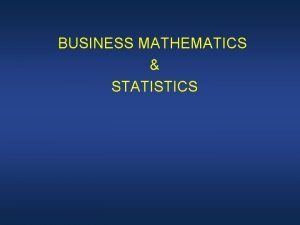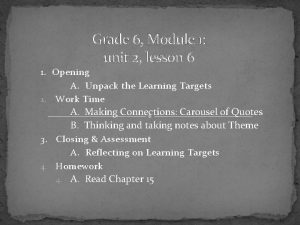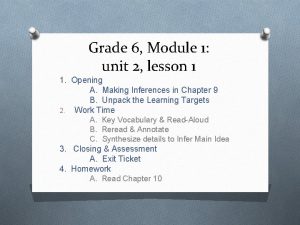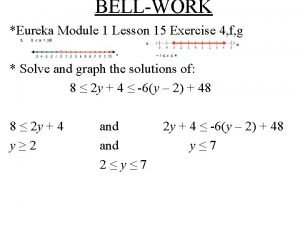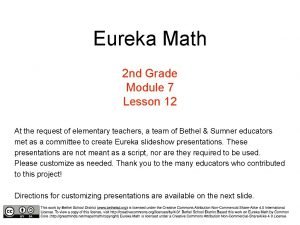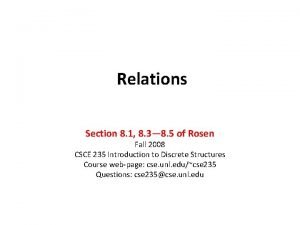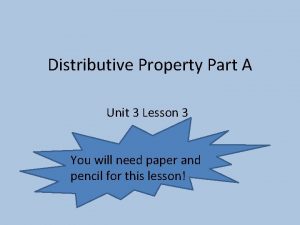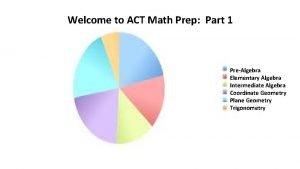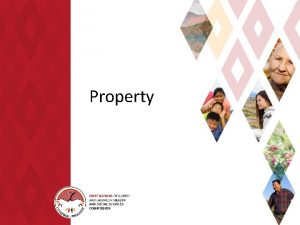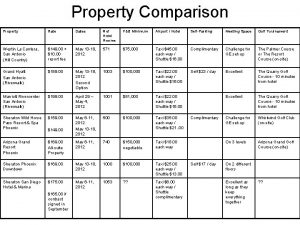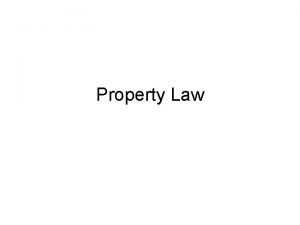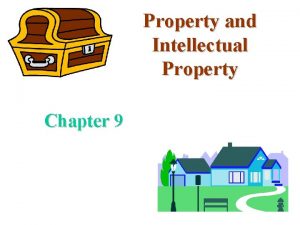Module Two Part 1 Property Data Hotel Math




























- Slides: 28

Module Two Part 1 – Property Data Hotel Math Fundamentals: The Metrics used by the Hotel Industry

Raw Data § Raw property sales data is directly exported from the systems of the hotel companies each month, week, and/or day increasing the reliability of the data. § Some hotels and smaller companies enter the data on the STR web site. Exam Worthy!

Sample Raw Data

STR Data Guidelines § STR uses a strict set of definitions based on the “Uniform System of Accounts for the Lodging Industry”. § Supply (Rooms Available) – the number of rooms in a hotel multiplied by the days in the month. § Demand (Rooms Sold) – number of rooms sold by a hotel, does not include complimentary rooms or “no-shows” (reservations not cancelled). § Revenue – total room revenue generated from the sale of rooms, not including taxes. Includes service charges not resort fees, nothing else such as F&B.

Key Performance Indicators From these raw data values, STR calculates the three hotel industry Key Performance Indicators (KPIs): § Occupancy - % § Average Daily Rate (or ADR) - $ § Revenue per Available Room (or Rev. PAR) - $ § important metric, based upon all rooms, combination of occupancy and ADR.

Occupancy = Demand ÷ Supply

ADR = Revenue ÷ Demand

Rev. PAR = Revenue ÷ Supply

Importance of Rev. PAR Exam Worthy! § Rev. PAR is a very important metric for the Hotel Industry since it is a combination of Occupancy and ADR. § A hotel could have a 100% Occupancy because of a low ADR. The Rev. PAR will reflect that. A hotel could have a very high ADR, but only sell one room. The Rev. PAR will reflect that as well. § Often people will talk about whether a Rev. PAR increase (or decrease) is attributed more to an increase (or decrease) in Occupancy or ADR. § Frequently when a hotel (or the GM) is evaluated or measured, Rev. PAR is the metric that is being looked at.

Rev. PAR % Change Exam Worthy! § Rev. PAR Percent Change is roughly the combination of Occupancy and ADR Percent Change. (This is great to know for checking your math. ) § If Occupancy Percent Change is 2% and ADR Percent Change is 2%, than Rev. PAR Percent Change will roughly be 4%. You have to actually do the math to get the exact amount. § If Occupancy Percent Change is 2% and ADR Percent Change is -2%, than Rev. PAR Percent Change will roughly be 0%. Again, you have to do the math to get the exact amount.

Percent Changes Definition: The comparison of the This Year (TY) number versus the Last Year (LY) number, whether a raw value or a KPI. The percent change illustrates the amount of growth (up, flat, or down) from the same period last year. Calculation: The “This Year” number minus the “Last Year” number divided by the “Last Year” number. This is a percentage. Percent Change = (This Year – Last Year) ÷ Last Year * 100

Percent Change = (This Year – Last Year) ÷ Last Year * 100

Percent Changes Real World Worthy! § Percent Changes are closely scrutinized by the industry. § A positive Percent Change indicates that the number this year is greater than the number last year. For example the Occupancy or ADR value is growing or improving. § A negative Percent Change indicates that the number this year is less than the number last year. For example the Occupancy or ADR value is decreasing or getting worse.

YTD Percent Changes

Percent Changes for Raw Values Real World Worthy! § Supply Percent Change shows whethere are more or less rooms available in the hotel(s) or market this year versus last year. § Demand Percent Change shows whethere are more or less rooms sold (guests spending the night) this year versus last year. § Revenue Percent Change shows whethere is more or less money being made by the hotel or hotels (and therefore being spent by those guests).

Occupancy is always related to Supply and Demand, even with Percent Changes Real World Worthy! § This is more than just a formula. It is an important basic principle. § If Supply remains the same and Demand goes up, then Occupancy will go up. § If Supply goes up and Demand remains the same, then Occupancy will go down § If Supply goes up and Demand also goes up, then you have to do the math to see what will happen to Occupancy. It will depend upon whether Supply or Demand increased at a higher rate.

Multiple Time Periods - Monthly Exam Worthy! § Year-to-Date (YTD) – January through the current month of the current year. § Running 12 -Month – the current month plus the prior 11 months, also called a 12 -Month Moving Average. § Running 3 -Month – the current month plus the prior two months. § Aggregate the Supply, Demand, and Revenue for all the months and then apply the Occupancy, ADR, and Rev. PAR formulas.

YTD KPIs

YTD Occupancy, ADR, & Rev. PAR

Multiple Time Periods - Daily § Current Week – the seven days, starting on Sunday and ending on Saturday. § Month-to-Date (MTD) – The 1 st of the current month through the current day of the month. § Running 28 -Day – the current day plus the prior 27 days. § Running 4 -Week – the current day plus the prior three same days of the week. Exam Worthy!

Fun with Excel Spreadsheets! § Go to the Mind Stretcher Folder in Laulima § Open the STR Exercises Folder § Open the Module 2 Folder § Click on the Hotel EXCEL Math Module 2, Part One File § Formulate the worksheets to calculate the required data in each of the 8 tabs of the spreadsheet § Refer to your power point for assistance with formulas

Occupancy = Demand ÷ Supply

ADR = Revenue ÷ Demand

Rev. PAR = Revenue ÷ Supply

YTD KPIs

YTD Occupancy, ADR, & Rev. PAR

YTD Percent Changes

This work is licensed under the Creative Commons Attribution 4. 0 International License (CC BY). To view a copy of this license, visit Creative Commons Attribution 4. 0 International License "This workplace product was funded by a grant awarded by the U. S. Department of Labor. All other uses require the prior authorization of the copyright owner. "
 Bentuk kepemilikan bisnis hotel
Bentuk kepemilikan bisnis hotel Hotel.hotelno=room.hotelno(hotel room)
Hotel.hotelno=room.hotelno(hotel room) Hyper-themed hotel: fantasyland hotel, canada
Hyper-themed hotel: fantasyland hotel, canada C device module module 1
C device module module 1 Unit meeting activities guides
Unit meeting activities guides Associative vs commutative
Associative vs commutative Obstructed heritage and unobstructed heritage
Obstructed heritage and unobstructed heritage Chemical properties of citric acid
Chemical properties of citric acid Hotel math fundamentals
Hotel math fundamentals Comp set data
Comp set data 00102-15 introduction to construction math
00102-15 introduction to construction math Business mathematics module 3 answer key
Business mathematics module 3 answer key Eureka math grade 6 module 1 lesson 6 answer key
Eureka math grade 6 module 1 lesson 6 answer key Grade 6 module
Grade 6 module Eureka math algebra 1 module 1 lesson 15
Eureka math algebra 1 module 1 lesson 15 Eureka math algebra 1 module 4
Eureka math algebra 1 module 4 Eureka math 3rd grade module 7
Eureka math 3rd grade module 7 Name the property math
Name the property math What is a transitive relation
What is a transitive relation 8004436657
8004436657 Unit 3 lesson 3 multiplying binomials
Unit 3 lesson 3 multiplying binomials Hit the button
Hit the button Act math prep part 1
Act math prep part 1 Part whole model subtraction
Part whole model subtraction Unit ratio definition
Unit ratio definition Brainpop ratios
Brainpop ratios Technical description examples
Technical description examples Cocktail bar parts
Cocktail bar parts The part of a shadow surrounding the darkest part
The part of a shadow surrounding the darkest part
